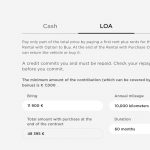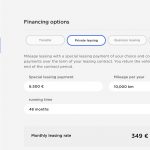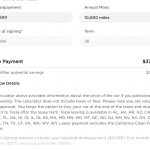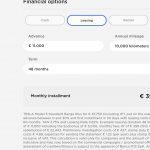

News
Tesla finally offers lease-to-buy options for Model 3 and Y, but it’s not available everywhere
Tesla is starting to offer the option to purchase its all-electric Model 3 and Model Y vehicles at the conclusion of a leasing period in some markets in Europe and Asia.
For some time, Tesla has not allowed owners to purchase their cars at the end of a leasing period. The car is to be returned to the automaker with no chance of a leaseholder buying out the car at the conclusion of the period. The car would be added to the company’s used inventory, to third-party resalers, or reserved for the future use of the Robotaxi fleet.
Tesla’s Leasing Program
Tesla’s leasing policy is one of the few automotive programs that is subjected to a required return policy at the conclusion of a leasing period. In its 2020 10-K filing with the SEC, Tesla details its process for receiving leased vehicles when the period is terminated.
The company states:
“Our used vehicle business supports new vehicle sales by integrating the trade-in of a customer’s existing Tesla or non-Tesla vehicle with the sale of a new or used Tesla vehicle. The Tesla and non-Tesla vehicles we acquire as trade-ins are subsequently remarketed, either directly by us or through third parties. We also remarket used Tesla vehicles acquired from other sources including lease returns.”
In some markets in the U.S., Canada, and Europe, Tesla did allow Model S and Model X leaseholders with the option to purchase the vehicle at the end of the lease period.
Tesla says:
“At the end of the lease term, customers are required to return the vehicles to us or for Model S and Model X leases in certain regions, may opt to purchase the vehicles for a pre-determined residual value.”
This program did not apply to the Model 3 or Model Y, as anyone who leased either of these cars would be required to relinquish possession of the vehicle with no chance of purchasing it at the end of the lease. However, Tesla added a new section to the 10-K in 2020, detailing the possibility of a lease-to-buy option in some markets in Europe and Asia, and it applies to the Model 3 and Model Y. The company writes, “This is not available with the Model 3 and Model Y,” on its website.
Lease-to-Buy Option for Model 3 and Model Y in Europe and Asia
Tesla added new language to the 2020 10-K filing that details its decision to allow lease-to-buy options on its vehicles in Europe and Asia.
The company wrote:
“We have outstanding direct leases and vehicles financed by us under loan arrangements accounted for as sales-type leases under ASC 842 in certain countries in Asia and Europe, which we introduced in volume during the third quarter of 2020. Depending on the specific program, customers may or may not have a right to return the vehicle to us during or at the end of the lease term. If the customer does not have a right to return, the customer will take title to the vehicle at the end of the lease term after making all contractual payments. Under the programs for which there is a right to return, the purchase option is reasonably certain to be exercised by the lessee and we therefore expect the customer to take title to the vehicle at the end of the lease term after making all contractual payments.”
In summation, Tesla is offering the option to buy a vehicle at the end of a lease in some markets. The customer has the option to return the vehicle as well in some cases, and Tesla is “reasonably certain” that the leaseholder will take possession of the vehicle title when the lease ends.
Teslarati obtained a list of the countries where this lease-to-buy option is available, according to the Online Design Studio. Some countries have explicit language that states the vehicle leaseholder must return the vehicle, while others indicate there is an option to purchase the car at the end of a lease. Some do not have any language that indicates what the leaseholder must do, which could indicate that the option to purchase the vehicle is available at the conclusion of the leasing period.
The countries where a lease-to-buy option is available are:
- Belgium
- Croatia
- Denmark
- France
- Italy
- the Netherlands
- Poland
- Taiwan
A few examples show that there is explicit language that indicates a lease can be purchased outright at the end of the period.
- France’s Design Studio contains language that indicates the vehicle can be purchased outright at the conclusion of a leasing period.
- Taiwan’s Design Studio explicitly states the vehicle can be bought outright at the end of a lease period.
Other Design Studio examples show that the vehicle must be returned to Tesla at the end of the leasing period.
- Tesla does not give the option to buy the vehicle outright at the end of the lease in Germany.
- Tesla explicitly tells U.S. leaseholders that they “forgo the option to buy your car at the end of the lease and must return it to Tesla after the lease term.”
Lastly, other Design Studios show no language either way, which seems to indicate the option to buy the car is available as the lease term expires.
- Tesla Poland has no explicit language stating that the car must be returned to Tesla.
- Tesla Italy also does not indicate specifically if the car should be returned to Tesla at the end of a lease.
Poland is one country where Tesla does not indicate whether the car is required to be returned at the end of a lease period. However, the option to buy the car at the end of the lease is available, according to one Polish Model 3 leaseholder who spoke to Teslarati. Model 3 leaseholder Szymon Janus said that Tesla does allow lease-to-buy options in his country of Poland, and at the end of the lease, can be purchased for “around 60% of the new car’s value,” he said. However, Tesla isn’t offering the lease-purchase option directly, it is operated through a bank, he says. This could be why Tesla has no explicit language depicting the required return of the vehicle at the lease’s end date.
Tesla has not revealed any further details within its 10-K filing that indicate whether the company will allow leased vehicles to be purchased at the end of a leasing period. However, it did detail some specific financial figures.
Tesla said:
“For the year ended December 31, 2020, we recognized $120 million of sales-type leasing revenue and $87 million of sales-type leasing cost of revenue.”
What do you think? Be sure to leave a comment below, or you can contact me directly at joey@teslarati.com or @KlenderJoey on Twitter.

Elon Musk
Elon Musk and Tesla AI Director share insights after empty driver seat Robotaxi rides
The executives’ unoccupied tests hint at the rapid progress of Tesla’s unsupervised Robotaxi efforts.

Tesla CEO Elon Musk and AI Director Ashok Elluswamy celebrated Christmas Eve by sharing personal experiences with Robotaxi vehicles that had no safety monitor or occupant in the driver’s seat. Musk described the system’s “perfect driving” around Austin, while Elluswamy posted video from the back seat, calling it “an amazing experience.”
The executives’ unoccupied tests hint at the rapid progress of Tesla’s unsupervised Robotaxi efforts.
Elon and Ashok’s firsthand Robotaxi insights
Prior to Musk and the Tesla AI Director’s posts, sightings of unmanned Teslas navigating public roads were widely shared on social media. One such vehicle was spotted in Austin, Texas, which Elon Musk acknowleged by stating that “Testing is underway with no occupants in the car.”
Based on his Christmas Eve post, Musk seemed to have tested an unmanned Tesla himself. “A Tesla with no safety monitor in the car and me sitting in the passenger seat took me all around Austin on Sunday with perfect driving,” Musk wrote in his post.
Elluswamy responded with a 2-minute video showing himself in the rear of an unmanned Tesla. The video featured the vehicle’s empty front seats, as well as its smooth handling through real-world traffic. He captioned his video with the words, “It’s an amazing experience!”
Towards Unsupervised operations
During an xAI Hackathon earlier this month, Elon Musk mentioned that Tesla owed be removing Safety Monitors from its Robotaxis in Austin in just three weeks. “Unsupervised is pretty much solved at this point. So there will be Tesla Robotaxis operating in Austin with no one in them. Not even anyone in the passenger seat in about three weeks,” he said. Musk echoed similar estimates at the 2025 Annual Shareholder Meeting and the Q3 2025 earnings call.
Considering the insights that were posted Musk and Elluswamy, it does appear that Tesla is working hard towards operating its Robotaxis with no safety monitors. This is quite impressive considering that the service was launched just earlier this year.
Elon Musk
Starlink passes 9 million active customers just weeks after hitting 8 million
The milestone highlights the accelerating growth of Starlink, which has now been adding over 20,000 new users per day.

SpaceX’s Starlink satellite internet service has continued its rapid global expansion, surpassing 9 million active customers just weeks after crossing the 8 million mark.
The milestone highlights the accelerating growth of Starlink, which has now been adding over 20,000 new users per day.
9 million customers
In a post on X, SpaceX stated that Starlink now serves over 9 million active users across 155 countries, territories, and markets. The company reached 8 million customers in early November, meaning it added roughly 1 million subscribers in under seven weeks, or about 21,275 new users on average per day.
“Starlink is connecting more than 9M active customers with high-speed internet across 155 countries, territories, and many other markets,” Starlink wrote in a post on its official X account. SpaceX President Gwynne Shotwell also celebrated the milestone on X. “A huge thank you to all of our customers and congrats to the Starlink team for such an incredible product,” she wrote.
That growth rate reflects both rising demand for broadband in underserved regions and Starlink’s expanding satellite constellation, which now includes more than 9,000 low-Earth-orbit satellites designed to deliver high-speed, low-latency internet worldwide.
Starlink’s momentum
Starlink’s momentum has been building up. SpaceX reported 4.6 million Starlink customers in December 2024, followed by 7 million by August 2025, and 8 million customers in November. Independent data also suggests Starlink usage is rising sharply, with Cloudflare reporting that global web traffic from Starlink users more than doubled in 2025, as noted in an Insider report.
Starlink’s momentum is increasingly tied to SpaceX’s broader financial outlook. Elon Musk has said the satellite network is “by far” the company’s largest revenue driver, and reports suggest SpaceX may be positioning itself for an initial public offering as soon as next year, with valuations estimated as high as $1.5 trillion. Musk has also suggested in the past that Starlink could have its own IPO in the future.
News
NVIDIA Director of Robotics: Tesla FSD v14 is the first AI to pass the “Physical Turing Test”
After testing FSD v14, Fan stated that his experience with FSD felt magical at first, but it soon started to feel like a routine.

NVIDIA Director of Robotics Jim Fan has praised Tesla’s Full Self-Driving (Supervised) v14 as the first AI to pass what he described as a “Physical Turing Test.”
After testing FSD v14, Fan stated that his experience with FSD felt magical at first, but it soon started to feel like a routine. And just like smartphones today, removing it now would “actively hurt.”
Jim Fan’s hands-on FSD v14 impressions
Fan, a leading researcher in embodied AI who is currently solving Physical AI at NVIDIA and spearheading the company’s Project GR00T initiative, noted that he actually was late to the Tesla game. He was, however, one of the first to try out FSD v14.
“I was very late to own a Tesla but among the earliest to try out FSD v14. It’s perhaps the first time I experience an AI that passes the Physical Turing Test: after a long day at work, you press a button, lay back, and couldn’t tell if a neural net or a human drove you home,” Fan wrote in a post on X.
Fan added: “Despite knowing exactly how robot learning works, I still find it magical watching the steering wheel turn by itself. First it feels surreal, next it becomes routine. Then, like the smartphone, taking it away actively hurts. This is how humanity gets rewired and glued to god-like technologies.”
The Physical Turing Test
The original Turing Test was conceived by Alan Turing in 1950, and it was aimed at determining if a machine could exhibit behavior that is equivalent to or indistinguishable from a human. By focusing on text-based conversations, the original Turing Test set a high bar for natural language processing and machine learning.
This test has been passed by today’s large language models. However, the capability to converse in a humanlike manner is a completely different challenge from performing real-world problem-solving or physical interactions. Thus, Fan introduced the Physical Turing Test, which challenges AI systems to demonstrate intelligence through physical actions.
Based on Fan’s comments, Tesla has demonstrated these intelligent physical actions with FSD v14. Elon Musk agreed with the NVIDIA executive, stating in a post on X that with FSD v14, “you can sense the sentience maturing.” Musk also praised Tesla AI, calling it the best “real-world AI” today.














